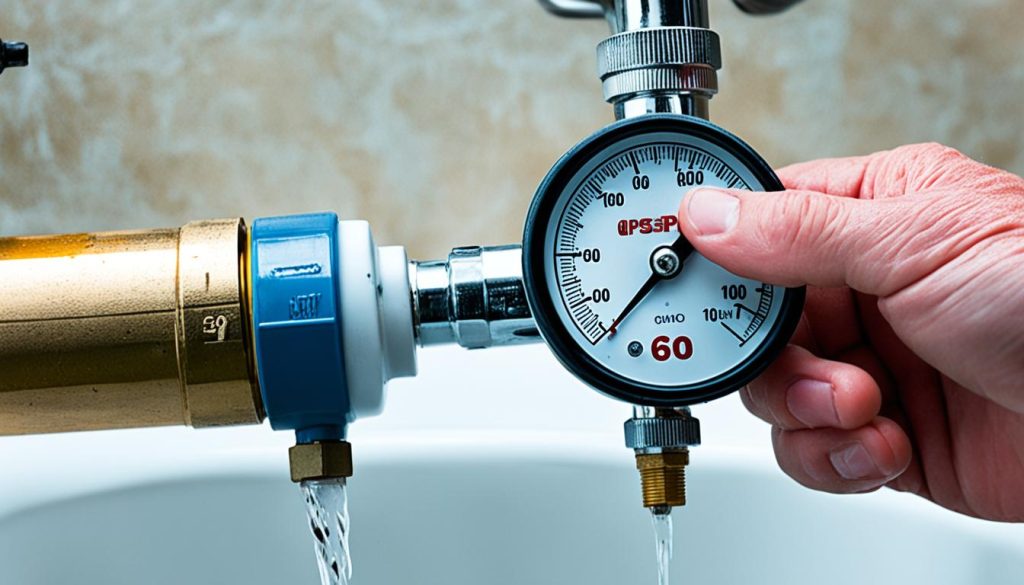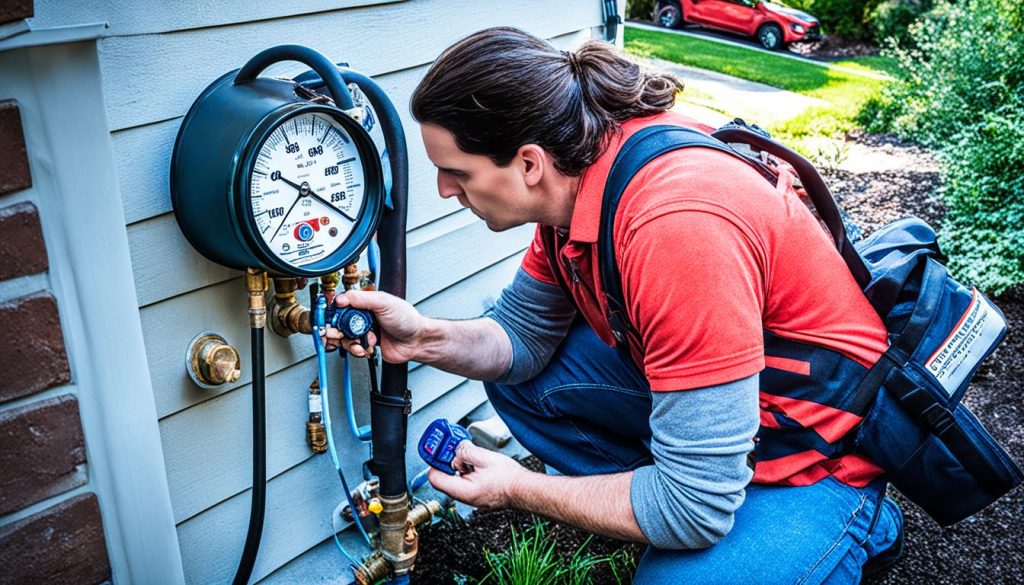Easy Guide: Check Home Water Pressure
Did you know that a staggering 80% of homes in Canada experience water pressure issues?
Testing the water pressure in your home is vital to ensure optimal water flow and prevent damage to your plumbing system. High water pressure can lead to plumbing issues, while low water pressure can result in weak water flow. By following this easy guide, you can learn how to check the water pressure in your home and take necessary actions to maintain it within the recommended range.
Key Takeaways:
- 80% of homes in Canada experience water pressure issues.
- Testing the water pressure is essential to prevent plumbing damage.
- High water pressure can lead to plumbing issues.
- Low water pressure can result in weak water flow.
- Regularly testing water pressure helps maintain optimal flow.
The Importance of Testing Home Water Pressure
Regularly inspecting and measuring the water pressure in your home is imperative to ensure smooth functioning of your plumbing system. Conducting a home water pressure inspection enables you to identify potential issues before they escalate, protecting your pipes, fixtures, and appliances from damage.
High water pressure can lead to a range of problems, including pipe leaks, bursts, and damaged connections. Excessive pressure can also cause issues with appliances such as dishwashers, washing machines, and water heaters. Additionally, it can lead to wastage of water and higher utility bills.
On the other hand, low water pressure can indicate a problem with the pressure regulator or restrictions in the water supply. This can result in weak water flow, making everyday tasks like showering, cleaning, and watering plants challenging and time-consuming.
By conducting a residential water pressure check on a regular basis, you can detect any deviations from the recommended pressure range and take necessary measures to address them promptly. This preventive approach helps you avoid costly repairs and ensures optimal water flow throughout your home.
Measuring water pressure is a straightforward process that can be done using a water pressure gauge, readily available at hardware or home improvement stores. With this simple tool, you can monitor the pressure in your home and take appropriate actions to maintain it within the ideal range.
The Risks of High Water Pressure
High water pressure can have detrimental effects on your plumbing system. The excessive force exerted by high pressure can lead to leaks, bursts, and damaged connections. Over time, this can weaken and degrade your pipes, resulting in costly repairs and potential flooding.
In addition to the damage to your plumbing system, high water pressure can also cause problems with appliances. It puts unnecessary strain on dishwashers, washing machines, and water heaters, reducing their efficiency and lifespan.
The Consequences of Low Water Pressure
Low water pressure can be equally frustrating and inconvenient in a home. It can affect various aspects of daily life, from taking showers to performing household chores. Additionally, low water pressure can indicate a larger issue with the pressure regulator or the water supply, which may require professional intervention to rectify.
The Importance of Maintaining Optimal Water Flow
By conducting regular home water pressure inspections, you can ensure that your plumbing system operates smoothly and efficiently. Maintaining optimal water flow is not only crucial for your comfort but also for the longevity of your fixtures, appliances, and pipes.
Next, we will explore how to conduct a simple DIY water pressure test using a pressure gauge.
How to Test Home Water Pressure
Testing the water pressure in your home is a simple process that requires a pressure gauge. You can easily purchase a gauge from a hardware or home improvement store. To measure the water pressure, follow these steps:
- Turn off all faucets and appliances that use water.
- Attach the pressure gauge to a hose bib or faucet closest to the water source.
- Open the faucet fully and check the gauge reading.
Ideally, the water pressure should be between 45 and 55 psi. If it falls below 40 psi or exceeds 80 psi, further actions need to be taken.
By conducting a DIY water pressure test using a water pressure gauge, you can quickly assess the water pressure in your home. It’s an essential step to ensure optimal water flow and identify any potential issues that may require attention. Regularly monitoring the water pressure allows you to take proactive measures and maintain a well-functioning plumbing system.
How to Address High or Low Water Pressure
Once you have tested the water pressure in your home, it is important to take appropriate actions based on the results. Troubleshooting water pressure issues promptly can help you maintain a properly functioning plumbing system. Here are some steps you can take to address high or low water pressure:
If the Water Pressure is Too High:
- Install a water pressure regulator: A water pressure regulator can help regulate the flow and prevent damage to your plumbing system. It ensures that the water pressure remains within the recommended range.
If the Water Pressure is Too Low:
- Inspect the pressure regulator: Check the pressure regulator to ensure it is functioning properly. If the pressure regulator is faulty or not adjusted correctly, it can cause low water pressure. Make necessary adjustments or replace the regulator if needed.
- Check the municipal water supply: If the pressure regulator is not the cause of low water pressure, there may be issues with the municipal water supply. Contact your local water department to inquire about any known problems or maintenance work that could be affecting water pressure in your area.
- Consider installing a water pressure booster: If all other options have been exhausted and the water pressure is still low, installing a water pressure booster can help improve the flow. A water pressure booster increases the pressure of the incoming water, ensuring better water flow throughout your home.
Troubleshooting and addressing high or low water pressure issues promptly can help you avoid further plumbing problems and maintain optimal water flow in your home.
Contact Mr. Rooter Plumbing for Help Troubleshooting Water Pressure Issues
If you’re experiencing difficulties with your water pressure or need assistance in testing, regulating, or boosting the water pressure in your home, it’s wise to seek professional help. Look no further than Mr. Rooter Plumbing, a trusted plumbing service provider with years of experience.
At Mr. Rooter Plumbing, we understand the importance of maintaining optimal water flow in your home. Our team of expert plumbers is equipped with the knowledge and skills to diagnose and fix any plumbing issues related to water pressure. Whether you’re dealing with high water pressure causing damage or low water pressure resulting in weak flow, we have the solution.
Schedule a service with Mr. Rooter Plumbing today, and our friendly technicians will be at your doorstep in no time. We utilize state-of-the-art equipment and advanced techniques to identify the root cause of your water pressure issues and implement effective solutions. Trust us to get your water pressure back to its recommended range, ensuring a properly functioning plumbing system.
Don’t let water pressure issues disrupt your daily activities. Contact Mr. Rooter Plumbing, the plumbing service provider of choice for countless homeowners in Canada. Rest assured, with our expertise and commitment to delivering exceptional service, your water pressure concerns will be resolved promptly and efficiently.
- Investing Wisely: How Windows & Doors in Boost Property Value and Financial Health - April 24, 2025
- The Financial Impact of Personal Injuries: Why Legal Help Matters for Business Owners - April 16, 2025
- The Hidden Financial Costs of Domestic Assault: What Business Owners Need to Know - April 16, 2025














